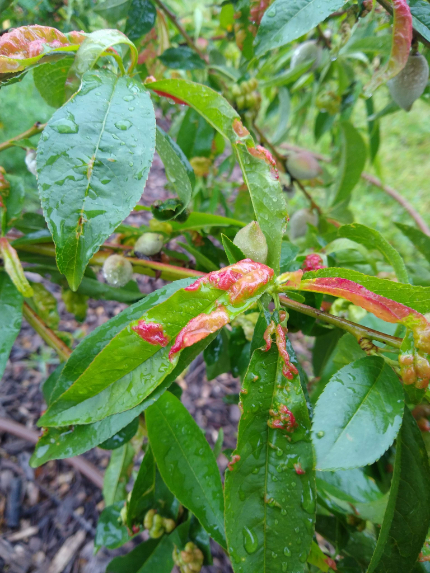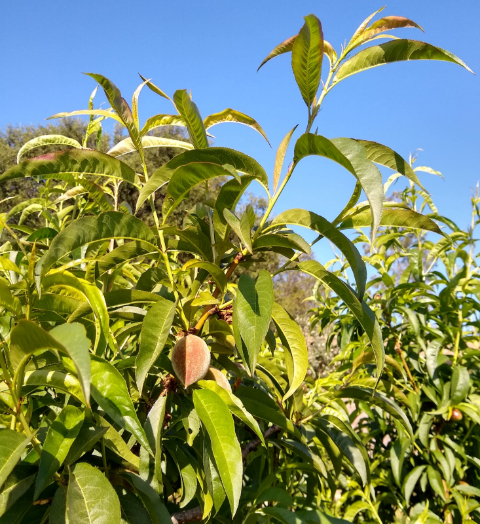Earlier this spring, a friend from Fallbrook was visiting and he mentioned that his peach tree had had a lot of leaf curl last year but this year there was no infection. “I finally got the spraying right!” he said.
Slowly, I said, “Those results might not be just because of your spraying. I don’t want to burst your bubble but I’ve never sprayed any of my peach or nectarine trees and they don’t have any leaf curl this year either.”
“What?”
(See that photo above? That’s the only leaf I could find in my yard that showed any infection today. There had been a few more leaves infected on a couple of varieties that I’d noticed last month, but they must have since dropped.)
“Remember the weather last spring?” I asked. “I don’t know exactly about your place, but here in Ramona we got six inches of rain in March, and then we got another six inches of rain in April. We never get that much rain that late in the spring. Wet spring weather when the peach trees are leafing out is exactly what the fungus that causes leaf curl needs to thrive.”
“OK,” he said.
“But think about how dry it’s been this spring by comparison. There hasn’t been any real rain since a little storm or two in early March, and February didn’t even have any rain.”
“That’s true.”
“I think it’s all about the weather, at least for my trees,” I continued. “If the spring is wet, they get leaf curl. If the spring is dry, they don’t. That’s what I’ve noticed on my trees and others that I see when I drive around. Not to say that you’re spraying didn’t do anything, but it’s possible that even if you hadn’t sprayed at all this year you wouldn’t have seen much leaf curl just because of the weather.”
Weather conditions that help or hinder peach leaf curl
Can we get any more specific about the weather conditions that Taphrina deformans, the fungus that causes peach leaf curl, likes or doesn’t like? I can’t. But researchers at the University of California do:
“Wetness from rain, dew, or irrigation for more than 12.5 hours at temperatures below 61°F is needed for infection. Maximum infection occurs when trees are wet for 2 or more days. . . Development of peach leaf curl ceases when young tissue is no longer developing or when weather turns dry and warmer (79° to 87°F).”
What should we do with this information?
It’s helpful to understand better why our trees look the way they do and vary in appearance from year to year. This year, spring has been dry and warm, and at least here is one upside to this weather.
If you’re interested in trying to fight peach leaf curl during cool, wet springs, see my post, “Dormant spray deciduous fruit trees?”
All of my Yard Posts are listed HERE








Interesting post! For what it’s worth, here in Clairemont my Eva’s pride peach tree looked like a cauliflower for a month. My Red Baron, however, was fine.
I wonder if the fact that one is an early peach tree and the other is a late one matters. The red baron is also less than a year from the nursery, where it may have gotten sprayed before I planted it…
Hi Brice,
It’s worth a lot! In fact, Eva’s Pride was the variety in my yard that had the most leaf curl this year. (It didn’t have much, but it had some.) Like in your yard, my Eva’s Pride leafed out earlier than most others. But May Pride also leafed out at about the same time and didn’t get leaf curl.
So it seems a combination of timing and variety sensitivity.
A family’s friend told me to plant garlic bulb around the base of the tree since garlic is a natural fungicide. I planted some last fall and so far I haven’t seen any leaf curl yet. But it could be due to a lack of rain in the spring.
Hi James,
Also, the fungus that causes leaf curl is said to live on the surfaces of the tree itself, not down in the soil below.
I was wondering if you ever get splitting on your peaches, and if its caused by overwatering, underwatering, inconsistent watering, or not related to watering at all!
Thanks
Hi Matt,
I get occasional split peaches but never much. Maybe your variety is particularly susceptible? Which variety is it?
I read in the “The Home Orchard” by Chuck Ingels that “Anything that damages the skin while the fruit is still small will cause the skin to crack or split as the fruit enlarges.” It says that sunburn can cause this, and the cracking or splitting can be enhanced by improper irrigation. Ample soil moisture in May and June are key, it adds.
Any of this sound like possible explanations?
Yeah it was probably improper irrigation. One fruit split badly and I pulled it before it brought in a bunch of disease. Wasn’t ripe but actually tasted kind of good.
But this morning I went out to find something ate 2 of 4 of my August Pride peaches. They were low hanging and eaten the way something with hands or paws might eat them, so I’m thinking a possum or something (probably the same critter responsible for the improper irrigation :). Anyway, I pulled the remaining peaches and put them in a bag to finish ripening.
The gall! Some guy is not watering optimally and then stealing fruit too!
I read in one of the research paper that early peaches are more susceptible to splits since their pit hardening stage is shorter than the late (cling stone) varieties.